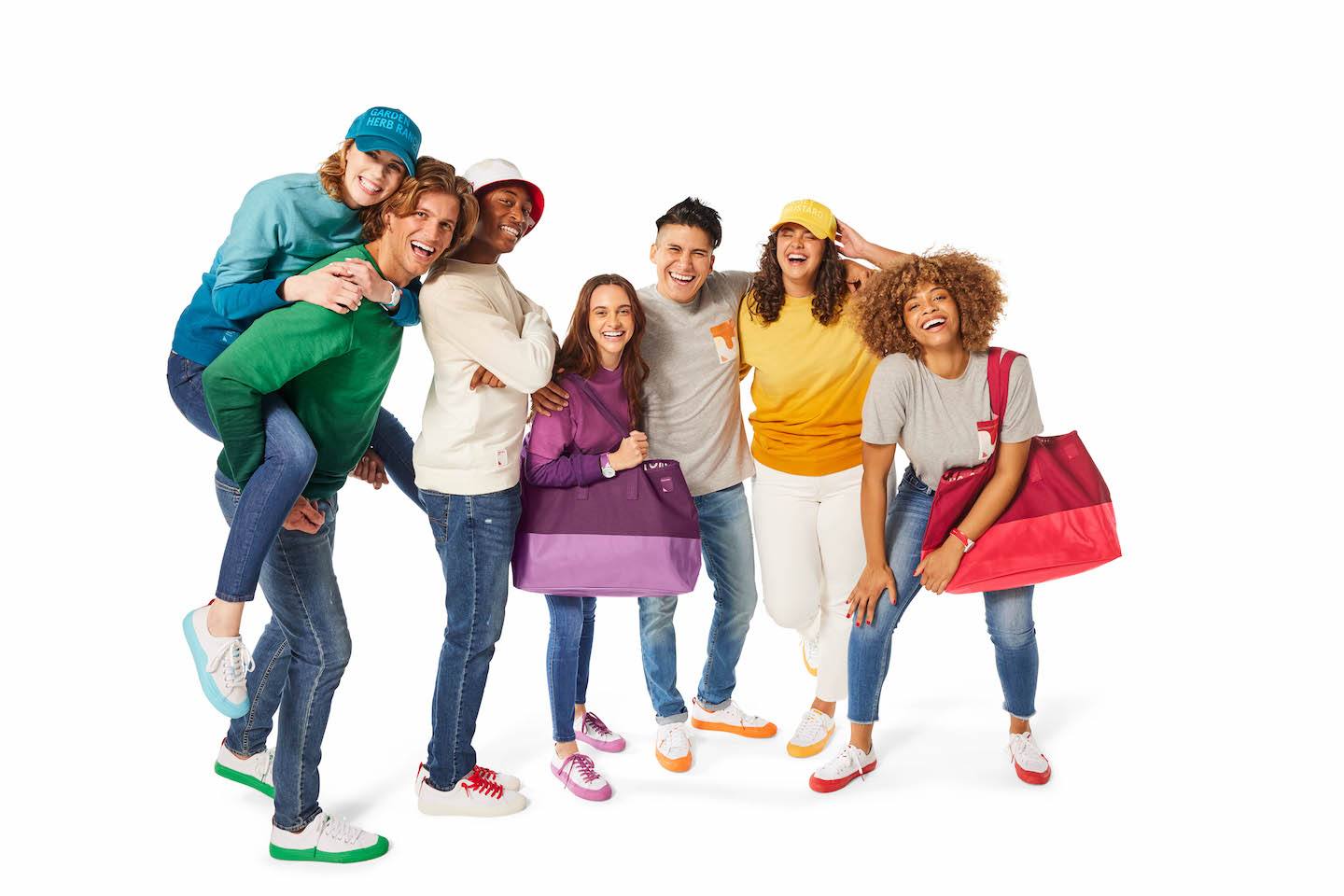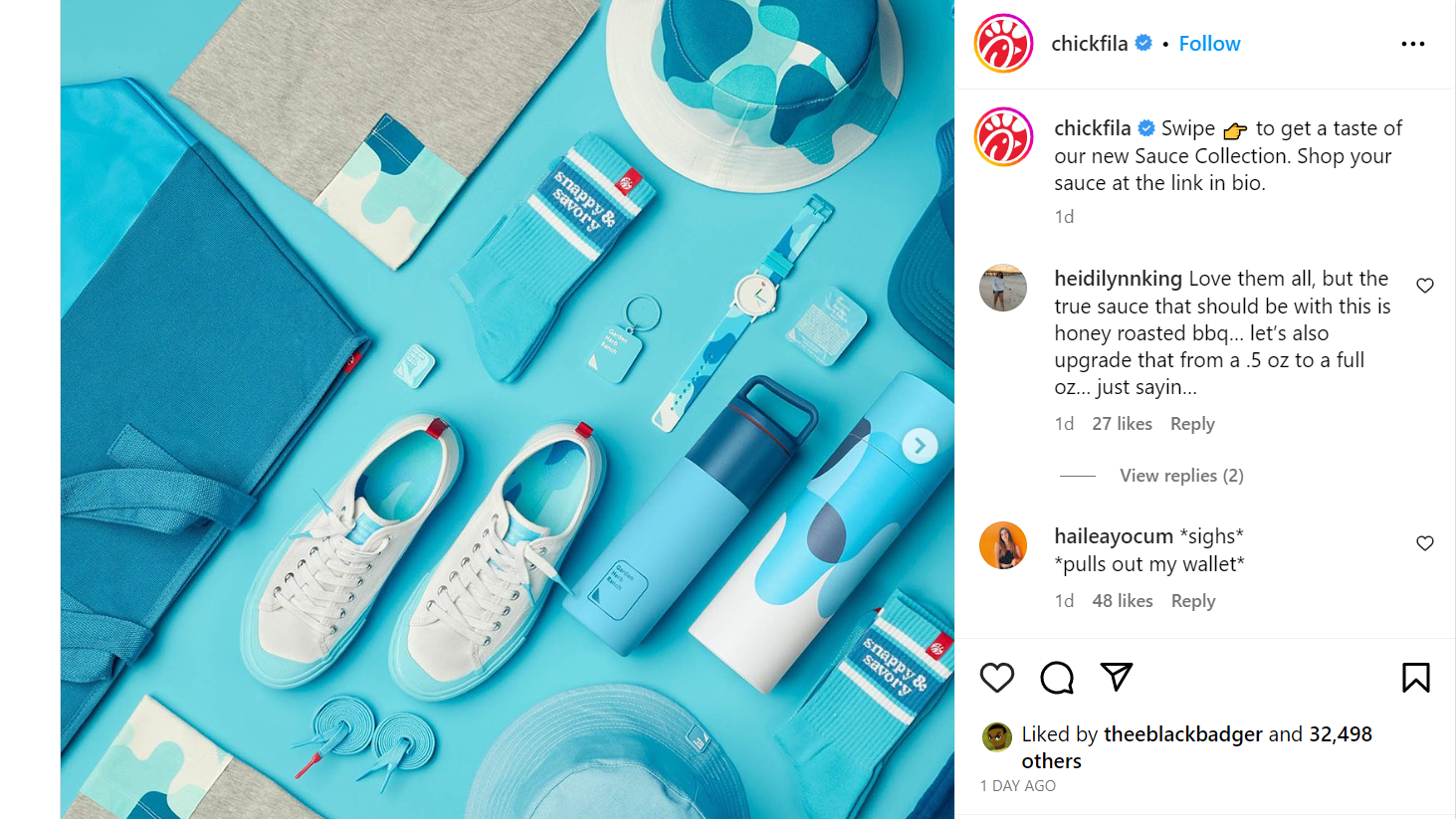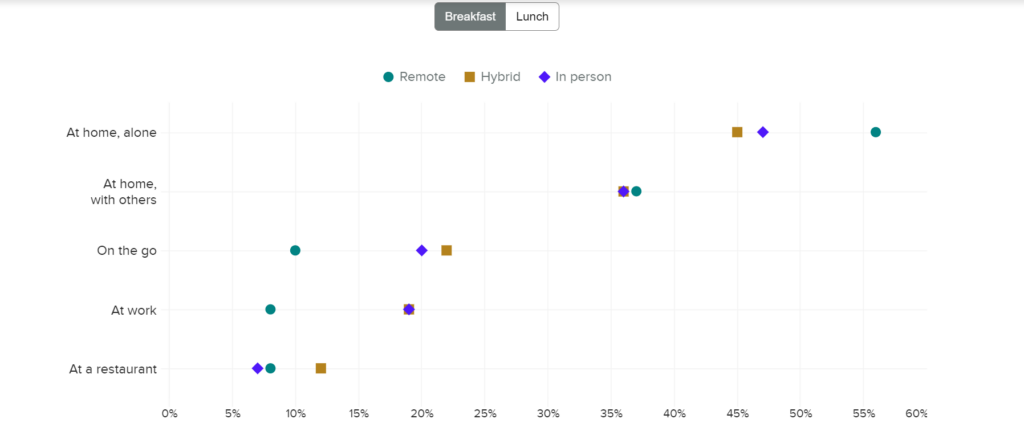Chick-fil-A debuts sauce merch, IG adds link in bio options and more
Plus: Lawsuits are starting around generative AI.

It’s time to get sauced (not that kind) because now you can wear what you dip your fries and nuggets in at Chick-fil-A.
Chick-fil-A recently debuted their new line of 11 clothing items based on your favorite sauce flavors with two new bottled sauce additions to their repertoire in time for the release, their website announced.
“At Chick-fil-A, we love that our guests have such passion for sauces. We wanted to create a way for fans to celebrate their favorite sauce flavors in style – beyond the restaurant. With signature sauce color palettes, the new merchandise line offers all the sauce, without the spill – featuring everything from sauce drip t-shirts to accessories inspired by each flavor,” Sara Storck, senior director of brand strategy on the website said of the announcement.
Their social media announcement also garnered a positive reaction from fans ready to wear their sauces and excited about the new changes.

Haileyayocum posted on Instagram, “*sighs* *pulls out my wallet.*
Lexiemcclellan posted, “whoever did this deserves a raise.”
Why it matters: What’s not to love about merch from a fast-food chain? Call it cheesy (we opt for saucy), but it’s smart branding for Chick-fil-A. This pairing of wearing one’s favorite sauce flavor hits for keeping the brand in front of consumers while doubling as free advertisement. Thinking of unique ways to keep brands in the minds of consumers is a fun, stylish marketing tactic. Now only if they have waffle fry hoodies.
Breakfast habits of workers vary based on where they work
To eat or not eat that bagel at home? It depends on if you’re remote, hybrid, or in-person, according to a Morning Consult survey.
According to the survey, remote workers would absolutely grab that bagel (or oatmeal, whichever) as they are 10 percentage points more likely to eat breakfast at home in comparison to their in-person counterparts.
“Breakfast habits are most likely to differ across worker types. Remote workers, who perhaps have more time in their morning schedule sans commute, are 10 points more likely to eat breakfast daily than in-person workers,” the survey adds. “This ‘when’ and ‘where’ in turn influences the products consumers select for breakfast.”

A screenshot from a Morning Consult survey based on location eating preferences from workers during a weekday
For breakfast, 56% of remote workers eat at home alone while 47% of in-person workers follow suit. Hybrid workers come in at 45% eating breakfast at home alone. Eating while on the go for remote workers drops down to about 10%; is at 20% for in-person workers and upticks slightly for hybrid workers at 22%.
Eight percent of remote workers opt to eat breakfast at a restaurant along with 7% of in-person workers and 12% of hybrid workers.
Why it matters: “The schedules of remote and hybrid workers will continue to have ramifications on food & beverage choices, from mealtimes to grocery shopping behaviors. Learning the ‘who’ behind worker profiles can help food & beverage brands more effectively tune messages and products as the landscape continues to shift,” according to the report.
Food and beverage brands have to be conscientious of who they are targeting and how. These brands will have to be savvy in their approach to connecting with these evolving consumers who primarily have an appetite for convenience.
Instagram gives users what they want with additional “link-in-bio” options
It’s been a long time coming for an Instagram change that allows users to add up to five links in their bio in addition, TechCrunch reported.
This change, announced by Mark Zuckerberg on his Instagram broadcast channel, came as a relief to many who have been previously restricted to either a single link or else a third-party tool like Linktree. Some see the move as a bid to gain an edge over TikTok, which also limits link options.
“The company likely sees how expanded access to links could be seen as a competitive advantage, potentially luring creators back to its app. In fact, Instagram calls out that its ability to add multiple links to a profile will be available to ‘all accounts,’ including business and creator accounts,” according to TechCrunch.
Why it matters: Social media brand managers, your life just got easier. Enjoy the luxury of those five links in the bio – but remember to be strategic about their order and directing people to the most impactful places.
Music producers scrub Drake sound-alike AI songs from the internet
A TikToker is in hot water after using AI to create a popular song sampling Drake’s voice in an unethical matter, resulting in a potential copyright infringement lawsuit, Newsweek reported.
Drake’s voice was used in the AI song, “Heart on My Sleeve,” which featured other artists apparently sampled, too, according to the story.
“The creation of AI-generated songs using artists’ voice likeness could be a violation of copyright law, suggested Universal Music Group, which publishes both artists through the label Republic Records,” according to the article.
UMG sent a statement to Newsweek, the article noted, saying that the “Heart on My Sleeve” song was “infringing content created with generative AI.”
Before this AI bust, UMG told other streaming sites to “block” the download of AI-generated songs, Financial Times originally reported. UMG added that the group would “not hesitate to take steps to protect our rights and those of our artists,” according to the article.
Why it matters: UMG acted swiftly in protecting the best interest of their artists by telling involved social media platforms to stop AI-generated songs from being downloaded and played.
While UMG is willing to embrace AI “they are wary of using it correctly,” Newsweek reported, which in these circumstances is justifiable.
A UMG spokesperson spoke out in a statement in the article.
“Which side of history all stakeholders in the music ecosystem want to be on: the side of artists, fans and human creative expression, or on the side of deep fakes, fraud and denying artists their due compensation.”
As generative AI continues to evolve brands should be on the lookout for copycats and the possibility of copyright infringements and what addressing that might look like.
Sherri Kolade is a writer at Ragan Communications. When she is not with her family, she enjoys watching Alfred Hitchcock-style films, reading and building an authentically curated life that includes more than occasionally finding something deliciously fried. Follow her on LinkedIn. Have a great PR story idea? Email her at sherrik@ragan.com.
COMMENT
PR Daily News Feed
RECOMMENDED READING
Tags: Drake







